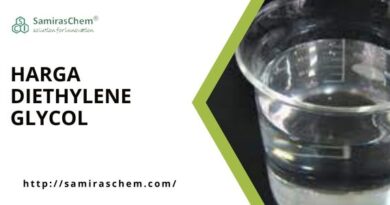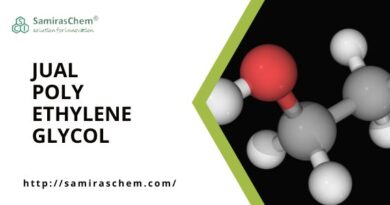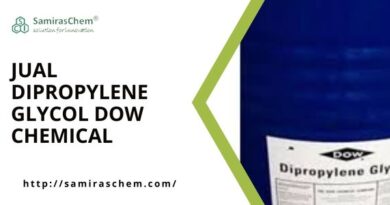Jual Diphenyl Oxide
Diphenyl oxide (DPO), also known as phenyl ether, is an aromatic ether with the chemical formula C12H10O. Its structure consists of two phenyl rings connected by an oxygen atom. DPO appears as a colorless or slightly yellow liquid or solid at room temperature and has a distinct floral odor, commonly associated with geraniums or lilacs. Its unique molecular arrangement endows it with numerous beneficial properties, which make it valuable in various applications across multiple industries, including fragrance, heat transfer fluids, and polymer processing.
Chemical Properties of Diphenyl Oxide
- Molecular Structure and Formula:
- Diphenyl oxide has the molecular formula C12H10O with a molecular weight of approximately 170.21 g/mol.
- Its structure consists of two benzene rings connected by an ether (oxygen) linkage, which contributes to its stability and chemical reactivity.
- Physical Properties:
- Appearance: A colorless crystalline solid or liquid, depending on ambient conditions.
- Melting Point: 28-30 °C.
- Boiling Point: 258-260 °C.
- Solubility: Insoluble in water but readily soluble in organic solvents like benzene, toluene, and alcohols.
- Vapor Pressure: Low vapor pressure at room temperature.
- Density: Approximately 1.07 g/cm³.
- Odor: Distinctly floral, which is why it is sometimes used in fragrance formulations.
- Chemical Properties:
- DPO is relatively inert due to its stable aromatic structure but can undergo nitration, halogenation, and other electrophilic substitution reactions on the benzene rings.
- It can serve as a base in some chemical reactions, particularly in producing thermal oils.
- It has a high flash point, making it thermally stable and safe for use in high-temperature applications.
Industrial Production of Diphenyl Oxide
Diphenyl oxide is typically synthesized via two main methods:
- Aromatic Nucleophilic Substitution:
- In this method, a phenol (such as phenol itself or a derivative) reacts with a halogenated benzene (such as chlorobenzene) in the presence of a base or catalyst, producing diphenyl oxide as a byproduct.
- Dehydration of Phenols:
- Another approach involves the condensation of two phenol molecules in the presence of an acid catalyst, leading to the formation of DPO and water.
The choice of synthesis method largely depends on factors like desired purity, scale of production, and economic considerations. The product is then purified through distillation or crystallization to obtain the desired grade for specific applications.
Applications of Diphenyl Oxide
Diphenyl oxide’s versatility stems from its physicochemical properties, especially its stability and thermal endurance, making it ideal for various industries:
- Heat Transfer Fluids (HTFs):
- One of the most common applications for diphenyl oxide is in the formulation of heat transfer fluids (HTFs) due to its high thermal stability and boiling point.
- DPO is often blended with biphenyl in HTFs, where the mixture operates efficiently at high temperatures. For example, in industrial systems requiring temperatures up to 400 °C, this blend offers stability and efficiency.
- HTFs are essential in power plants, chemical processing, and manufacturing industries where maintaining and transferring heat is necessary.
- Fragrance and Perfumery:
- Diphenyl oxide’s floral odor is prized in perfumery, especially for imparting fresh, geranium-like notes to fragrance formulations.
- Its unique scent profile makes it a suitable fixative and fragrance enhancer in soaps, detergents, and personal care products. It helps maintain scent longevity and improves the fragrance’s overall complexity.
- In combination with other ingredients, it can contribute to more elaborate and nuanced scent profiles in high-end perfumes.
- Polymer Processing:
- DPO acts as a polymerization catalyst and stabilizer in the production of certain polymers, particularly polycarbonates and polyesters.
- Its role in polymer processing includes facilitating the reaction and helping maintain desired mechanical and thermal properties.
- In addition, DPO is sometimes used as a plasticizer or modifier in polymers to enhance flexibility and durability.
- Chemical Intermediates and Synthesis:
- Diphenyl oxide serves as a building block for synthesizing various derivatives, particularly in producing phenyl ethers and specialty chemicals.
- It is used as an intermediate in producing other aromatic ethers and related compounds, where it contributes to the stability and functionality of the final products.
- Additionally, DPO derivatives find use in certain dyes and pigments, especially those requiring high thermal stability or resistance to degradation.
- Pharmaceuticals:
- While not commonly used as an active pharmaceutical ingredient (API), DPO is sometimes employed in the synthesis of compounds with therapeutic potential.
- Certain derivatives have shown activity against microbial and fungal infections, leading to further exploration of DPO-based molecules in drug discovery.
- Agricultural Industry:
- Diphenyl oxide has been explored as a pesticide or herbicide, primarily through its derivatives, which exhibit insecticidal or fungicidal properties.
- While its direct use in agriculture is limited, ongoing research on its derivatives continues to identify potential applications in pest control.
Safety and Environmental Considerations
- Health Hazards:
- Exposure to diphenyl oxide, particularly at high levels, can cause skin and eye irritation, respiratory distress, and other symptoms.
- Prolonged exposure or high-dose inhalation may lead to systemic toxicity, necessitating proper handling protocols.
- DPO is classified as a skin and eye irritant, and chronic exposure may cause other health concerns, especially for individuals working in industrial settings.
- Environmental Impact:
- DPO is not considered highly toxic to aquatic life, but its persistence in the environment may lead to bioaccumulation.
- Given its low biodegradability, DPO should be managed carefully to prevent long-term environmental contamination, especially in areas where HTFs are in use.
- Handling and Storage:
- It’s recommended to store DPO in a cool, well-ventilated area, away from direct sunlight and heat sources.
- Proper protective equipment (gloves, goggles, and respiratory protection) is essential when handling DPO in industrial settings.
- In case of spills, DPO should be contained and cleaned up immediately to prevent environmental contamination.
Advantages and Disadvantages of Diphenyl Oxide
- Advantages:
- Thermal Stability: Its high boiling point and flash point make DPO ideal for high-temperature applications, especially in HTFs.
- Aromatic Odor: The pleasant floral odor of DPO makes it valuable in fragrance applications.
- Versatility: It serves as an intermediate for numerous chemicals and is used in various industries, including polymer manufacturing, perfumery, and HTFs.
- Low Vapor Pressure: Reduces volatilization risks in open systems, which is beneficial in high-temperature operations.
- Disadvantages:
- Toxicity: Inhalation or prolonged exposure may lead to health issues.
- Environmental Persistence: DPO’s resistance to degradation can lead to environmental concerns if not managed correctly.
- Cost: Industrial-grade DPO can be costly, especially when high purity is required.
Future Directions and Research on Diphenyl Oxide
Ongoing research on DPO focuses on optimizing its performance in existing applications and identifying new uses. Some key areas include:
- Improving Heat Transfer Efficiency:
- Research is directed at enhancing the efficiency of DPO-based HTFs to extend their use in renewable energy sectors, like solar thermal power.
- Developing Safer Derivatives:
- The development of less toxic and more environmentally friendly DPO derivatives is underway to reduce its environmental footprint and increase applicability in fields like pharmaceuticals and agriculture.
- Enhancing Fragrance Longevity:
- In perfumery, innovations focus on utilizing DPO to extend fragrance longevity and stability, especially in complex formulations that mimic natural floral scents.
Conclusion
Diphenyl oxide is a versatile and valuable compound in industrial chemistry, with a wide range of applications from HTFs and fragrance formulations to polymer processing. Its unique chemical properties, such as high thermal stability and aromatic scent, make it indispensable in industries where both functionality and sensory appeal are essential. However, as with many industrial chemicals, careful handling and environmental consideration are crucial for its safe and sustainable use. The ongoing research into safer derivatives and alternative applications promises to expand its utility while mitigating some of the associated health and environmental concerns. Diphenyl oxide exemplifies how a single chemical can intersect with multiple domains, illustrating the dynamic interplay between chemistry, industry, and environmental stewardship.



